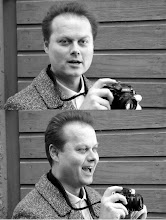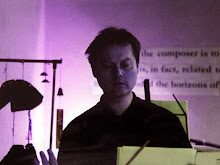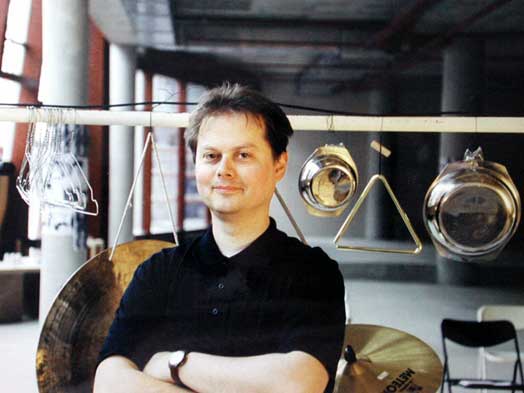An Introduction to POEMS YOU SEE BEFORE YOU DIE
by George H.E. Koehler (poems) and Ray Rubeque (pictures)
Haiku as a literary form is something many Westerners are only vaguely familiar with, if at all. I first became aware of the existence of haiku in 1973, when I read Ian Fleming‘s You Only Live Twice, where a haiku is used as the motto and its first line originated the book‘s title. Whether Fleming simply put his words into Bashô‘s mouth to let his thriller appear grounded in Japanese culture, or whether Bashô really did create that poem, I could never clear up. Then, around 1974, I caught my first haiku virus proper in high school, when an English teacher playfully introduced his pupils to this originally Japanese form by challenging us to express ourselves within its restrictions.
Haiku and its related forms senryu and tanka stand for compression and concentration – their formal restraints force the poet to present a maximum of information within a very limited number of syllables. The very compactness and structural clarity of haiku encourages succinctness, yet also leads to a high degree of symbolism in its more successful examples. Accomplished haiku always leave enough room for suggestion.
Although there are several general rules, they are, increasingly, not always followed. Traditional Japanese haiku has 17 syllables (onji) divided into 3 lines counting 5 syllables, 7 syllables, and 5 syllables respectively. This arrangement is often ignored by writers in other languages, however, the basic sequence of 3 short lines, with a middle line slightly longer than the other two, is generally observed, though US haiku writers tend to dismantle even this.
Haiku divides into two parts, with a break coming after the first or second line, so the poem seems to make two separate statements related in some unexpected or indirect way. This break is marked in Japanese by what is called a cutting word (kireji), whereas in English and other languages it is often emphasized by or even created with punctuation. This two-part structure is meant to provoke a sense of discovery, or a sudden insight, as one reads along, important for the blossoming of the poetic effect of haiku.
Haiku is supposed to include a kigo – a word that gives the reader a clue to the season being dealt with. The kigo is also important to the haiku‘s effect, in that it may anchor the experience it describes in a poetic here and now, thereby helping to sharpen the imaginative focus. The poem`s reference to nature need not be a direct statement, it can take the form of an implied allusion, instead.
Haiku must also refer to something concrete, not to an abstraction or generalisation and to something that exists now, not something from the past. Haiku poems present a snapshot of everyday experience, to reveal an unsuspected significance in a detail of nature or human life. The haiku poet finds his subject matter in the world around him, not in ancient legends or exotic fantasies. The aim of haiku is to make the reader feel what the writer has felt. He writes for a popular audience and gives it a new way to look at things they may have overlooked in the past.
Daisetz Teitaro Suzuki (1870 - 1966) emphasized the importance of haiku‘s suggestive nature: When something is too fully expressed, there is no room for suggestion anymore. Suzuki wrote that when the greatest feelings are reached, there is silence because words do not suffice for expression. Looked at in this way, even 17 syllables may be too many words.
Haiku‘s unique verse form has attracted the interest of many outside Japan. It is often difficult to retain the 17-syllable pattern, when writing in English. One reason is the syllable, as a unit, is defined differently in English than in Japanese. Another is that, in Japanese haiku certain words can be used for punctuation, as well, whereas this device is not available in English. Besides that, writers in English can reach no agreement on the use of rhyme or necessity of words and phrases alluding to nature. These and other difficulties suggest it may be impossible to limit English haiku to rules that defining the original Japanese form. Jack Kerouac, for instance, thought Western haiku need not necessarily subscribe to 17 syllables, just concentrate on 3 short lines that say a good deal free of poetic trickery. In Some of the Dharma he reworked the definition of the form, and called his version American haiku pop, presenting it as a 3-line poem of Buddhist connotation, a small meditation that may or may not rhyme, and which leads to enlightenment, with pop being the quick, abrupt noise that grabs your attention.
Alan Watts (1915 - 1973) wrote that haiku seeks to evoke the sense of potentiality – indicating but not explaining. Haiku should evoke the mood of mystery that is yugen. Watts also described other moods that haiku try to bring out in the reader, such as Sabi, the feeling of being peacefully alone, and aware, which describes a sadness akin to nostalgia and a recognition of impermanence. According to Watts, aware is most powerful in poetry that describes this transience.
Senryu is structurally identical to haiku, that is, a 5-7-5 syllable poem, but has a much more flexible content, particularly in discussing human emotions and relationships as opposed to nature themes. It does not require the inclusion of a seasonal word.
Karai Hachiemon (1718 -1790) was a government official in the Asakusa district of Edo (now Tokyo). Under his pen name Senryu, meaning River Willow, he was also a noted poet, who acted as judge at contests of maekuzuke (verse capping). In this traditional form of literary amusement, a given short verse of 14 syllables (7+7) was capped by a longer verse of 17 syllables (5+7+5) to produce a 31-syllable poem similar to the traditional waka form. The many anthologies of these capping portions, known as tsukeku, that Senryu compiled under the title Yanagidaru, led tsukeku to become read and appreciated by themselves, and they sparked off a new genre with the editor‘s pen name now inseparably linked to it.
The main difference between senryu and haiku is one of tone. The meaning and structure of a haiku can be brilliant, but they can often be conventionally serious and sentimental, offering few surprises. One has to be a near genius to write good haiku, whereas almost anyone can write reasonably good senryu – this form seems somehow to have escaped the structural restrictions that bind and, perhaps, limit haiku too much. Whereas haiku often call for analysis, a typical response to senryu is often a laugh or a chuckle or an exclamation like That‘s so true! Expressing everyday truths, in succinct verse – that‘s often the appeal of senryu.
The first ever Japanese poem was probably written during the 6th century. Prior to that, Japanese had not existed as a written language. Developing out of trade relations, Koreans, acting as go-betweens between Chinese and Japanese culture, set a development of Japanese characters out of Chinese characters in motion, leading the Japanese to turn from a purely oral culture to a written culture.
The choka poems from the 6th and 7th Century had between 50 and 100 lines with alternating lines of 5 and 7 syllables and a last line with 7 syllables.
By the 9th Century, the shorter waka had evolved out of the choka and arisen to great popularity as a courtly pastime. Waka were composed of 5 lines with a total of 31 syllables in a 5-7-5-7-7 sequence.
Renga is the poetry contest form of waka, it came into being around the 11th Century. One person would provide the last 2 lines of a poem, then another person had to compose the first 3 lines. Put together, all lines had to make a meaningful 31-syllable poem.
Approximately 500 years ago, haikai, a social phenomenon of the then new urban masses, finally emerged out of this courtly contest form. Haikai, the predecessor of haiku, consisted of the first 3 lines of the 31-syllable renga poems. The first important representative of this form, who remains revered to this day, was Matsuo Bashô (1644 - 1694). It was, however, Masaoka Shiki (1867-1902) who gave haikai the name under which it is now famous – haiku.
The expression tanka is the modern term for waka, applied to those 31-syllable poems written since the early 20th Century. Waka refers to the pre-20th-Century 31-syllable poems, written in an older idiom. Tanka are often composed of 2 parts: the 5-7-5 choku part and the 7-7 tanku part, though this division varies, as opposed to its predecessor, the waka. Unlike haiku, they are not generally restricted to nature or to the use of season words.
In writing a haiku the aim is, essentially, to achieve the depiction of a firsthand experience of the world around you, by encapsulating the feeling of a scene as accurately as possible, using only a few simple elements. Ideally, from a Zen point of view, a haiku should bring the reader directly to the experience in an intimate sharing of an ordinary moment, presenting the whole of life in that one event. The real experience is conveyed in the present tense, working to promote insight or satori and evoke feelings like awe, surprise, and joy in the reader.
The haiku of the japanese poet Bashô achieve this in a particularly exemplary manner. To this day, he is considered the finest writer of this genre, particularly during its formative years. Bashô (real name Matsuo Munefusa) was born into a samurai family prominent among nobility, but he rejected that world and became a wanderer, instead. Studying Zen, history and classical Chinese poetry, he lived in apparently blissful poverty under a modest patronage and from donations by his many students.The structure of his haiku reflects the simplicity of his meditative life. When he felt the need for solitude, he withdrew to his basho-an, a hut made of plantain leaves (bashô) which his students had originally built for him – hence his pseudonym. He infused a mystical quality into much of his verse and attempted to express universal themes through simple natural images, from the harvest moon to fleas in his cottage.
Bashô brought to haiku the Way of Elegance (fuga-no-michi), deepened its Zen influence, and approached poetry itself as a way of life (kado, the way of poetry) in the belief that poetry could be a source of enlightenment. Achieve enlightenment, then return to this world of ordinary humanity, he advised. His attention to the natural world transformed the haikai verse form from a formerly frivolous social pastime into a major genre of Japanese poetry, creating a door to meditation and contemplation.
Other equally remarkable and worthwhile poets to explore are Yosa Buson, Issa, Kikaku, Masaoka Shiki and Shoichi.
Traditional haiga is a haiku-inspired art, and originally evolved from nanga art which flourished in Japan during the late Edo period, from the 17th to mid-19th century. Just as many Japanese artists and writers of this period were heavily influenced by Chinese culture, so was nanga patterned after a Chinese school of painting, known as the nanzonghua.
In the haiga format, textual and visual elements are presented together in such a way that they share a common document. Traditionally, despite combining them, the aim is to have the haiku text and the accompanying picture executed so that they can function on an equal footing – and thus have two worlds coexist on a common surface. The challenge, here, for the artist was in finding the ideal manner of execution, to express the respective rules and aesthetic embodied in each haiku, but create a content that is independent of the poem.
Usually, calligraphic illustrations of traditional haiga were done by the person who wrote the haiku, though the picture was supposed to remain a self-contained piece of art and not become a too literal illustration of the idea embodied in the haiku.
Towards the end of our work on this book, we realized we had not only amassed a collection of haiku, senryu and tanka, but had in effect, created a collection of interactions very akin to the Japanese haiga, where the content of a text is complemented by a visual language that is supposed not to echo it. At this point, however, we differ from traditional haiga, since textual context in our work is transformed into a visual language, and vice-versa. In addition, the picture titles are designed to contextually bridge the meaning of the picture with the poem.
The pairing of the written word with b&w drawings leads to a further development of a pictorial language of suggestion and stringency that haiku, senryu and tanka automatically embody. Although the pictures were evolved out of the poems, they are not mere illustrations, they exist in their own right, though they touch on ideas, sometimes focusing on aspects of the poems, sometimes commenting on and developing ideas in the poems, often expanding their meanings beyond the original intention, sometimes offering satirical comment on the lyrical tone of a poem. The aim is to invite the reader to embark with us upon this stretching out within the haiga genre. Hopefully, this book will make you smile, reflect upon life, and allow the realization that poetry can be found in anything.
"Seek not the paths of the ancients; seek that which the ancients sought." Readers, heed the poet Bashô‘s challenge: Oppose the pre-ordained roads and preconceptions that elders, and societies set up before you. Don‘t simply imitate others without thinking, in the hope you may become like your idols, no, do your own thing. Search for that which your precursors sought, just as Bashô urged.
George H. E. Koehler
March 2009
Friday 3 April 2009
PYSBYD worry-stone edition Issue #1 on sale at T3 in Frankfurt !

Issue #1 of the POEMS YOU SEE BEFORE YOU DIE pocket magazine is on sale at T3 TERMINAL ENTERTAINMENT in Frankfurt on Main, for a bargain EUR 2,00.
Grab your worry-stone edition right now!
T3 is a great comics and more shop located at
Große Eschenheimer Str. 41 A
60313 Frankfurt am Main
Phone: (0 69) 28 75 69
LINK TO T3 website
Companion Pictures to the poems from PYSBYD on show at deviantART

A Selection of the companion pictures to the poems from POEMS YOU SEE BEFORE YOU DIE is on show at Rektozhan's online Gallery at deviantART.
LINK
Rektozhan's Gallery
Subscribe to:
Posts (Atom)




